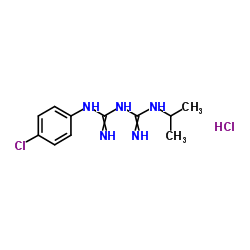proguanil hydrochloride

proguanil hydrochloride structure
|
Common Name | proguanil hydrochloride | ||
|---|---|---|---|---|
| CAS Number | 637-32-1 | Molecular Weight | 290.192 | |
| Density | N/A | Boiling Point | 402.7ºC at 760 mmHg | |
| Molecular Formula | C11H17Cl2N5 | Melting Point | 249-251ºC | |
| MSDS | Chinese USA | Flash Point | 197.4ºC | |
| Symbol |

GHS06 |
Signal Word | Danger | |
|
CYP2C19*17 increases clopidogrel-mediated platelet inhibition but does not alter the pharmacokinetics of the active metabolite of clopidogrel.
Clin. Exp. Pharmacol. Physiol. 41(11) , 870-8, (2014) The aim of the present study was to determine the impact of CYP2C19*17 on the pharmacokinetics and pharmacodynamics of the active metabolite of clopidogrel and the pharmacokinetics of proguanil. Thus, we conducted an open-label two-phase cross-over study in 3... |
|
|
The antimalarial drug proguanil is an antagonist at 5-HT3 receptors.
J. Pharmacol. Exp. Ther. 351(3) , 674-84, (2014) Proguanil is an antimalarial prodrug that is metabolized to 4-chlorophenyl-1-biguanide (CPB) and the active metabolite cycloguanil (CG). These compounds are structurally related to meta-chlorophenyl biguanide (mCPBG), a 5-hydroxytryptamine 3 (5-HT3) receptor ... |
|
|
Paper test cards for presumptive testing of very low quality antimalarial medications.
Am. J. Trop. Med. Hyg. 92 , 17-23, (2015) Carrying out chemical analysis of antimalarials to detect low-quality medications before they reach a patient is a costly venture. Here, we show that a library of chemical color tests embedded on a paper card can presumptively identify formulations correspond... |
|
|
Questionnaire-based analysis of atovaquone-proguanil compared with mefloquine in the chemoprophylaxis of malaria in non-immune Japanese travelers.
J. Infect. Chemother. 19(1) , 20-3, (2013) Malaria is one of the most common and serious infectious diseases in the tropics and subtropics. For high-risk travelers to endemic regions, malaria chemoprophylaxis is recommended. Internationally, atovaquone-proguanil (A/P), mefloquine (MEF), or doxycycline... |
|
|
Malaria therapy in HIV: drug interactions between nevirapine and quinine.
Int. J. STD AIDS 22(12) , 768, (2011) We report the case of an HIV-positive Nigerian man on antiretroviral therapy (ART) with an undetectable viral load who presented with rigors, fever and back pain after returning to the UK from a three-week trip to Nigeria. Infection with Plasmodium falciparum... |
|
|
Erythema multiforme and Malarone(®).
Travel Med. Infect. Dis. 10(5-6) , 279-80, (2012)
|
|
|
Artemether-lumefantrine compared to atovaquone-proguanil as a treatment for uncomplicated Plasmodium falciparum malaria in travelers.
Am. J. Trop. Med. Hyg. 92(1) , 13-7, (2015) Atovaquone-proguanil (AP) and artemether-lumefantrine (AL) are both treatments for uncomplicated Plasmodium falciparum malaria, but comparative clinical trials are lacking. We performed a retrospective analysis, comparing treatment failure and fever clearance... |
|
|
Incidence of malaria among mosquito collectors conducting human landing catches in western Kenya.
Am. J. Trop. Med. Hyg. 88(2) , 301-8, (2013) The human landing catch (HLC) has long been the gold standard for estimating malaria transmission by mosquitoes, but has come under scrutiny because of ethical concerns of exposing collectors to infectious bites. We estimated the incidence of Plasmodium falci... |
|
|
A longitudinal trial comparing chloroquine as monotherapy or in combination with artesunate, azithromycin or atovaquone-proguanil to treat malaria.
PLoS ONE 7(8) , e42284, (2012) The predominance of chloroquine-susceptible falciparum malaria in Malawi more than a decade after chloroquine's withdrawal permits contemplation of re-introducing chloroquine for targeted uses. We aimed to compare the ability of different partner drugs to pre... |
|
|
Assessing the consistency assumption by exploring treatment by covariate interactions in mixed treatment comparison meta-analysis: individual patient-level covariates versus aggregate trial-level covariates.
Stat. Med. 31(29) , 3840-57, (2012) Mixed treatment comparison (MTC) meta-analysis allows several treatments to be compared in a single analysis while utilising direct and indirect evidence. Treatment by covariate interactions can be included in MTC models to explore how the covariate modifies ... |